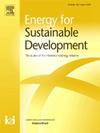Solar photovoltaic (PV) diffusion and synergies with resilience, adaptation, and sustainable development: A case study in Laguna Lake watershed, the Philippines
IF 4.9
2区 工程技术
Q2 ENERGY & FUELS
引用次数: 0
Abstract
Solar energy systems, either land- or water-based, have a huge potential for net-zero transition and generate multiple co-benefits despite the possible risks of not being designed or installed properly. Existing literature has revealed both positive and negative impacts of solar photovoltaic (PV) from the viewpoints of engineering design, energy system's stability, environment, and socio-economic aspects. However, little has been known about solar PV's multi-dimensional impacts on resilience of local farmers and fishermen under climate change. To fill this gap, this paper assessed the kinds of positive and negative impacts on resilience that could be generated by land- and water-based solar systems and how various policies could be harmonised to synergise solar energy diffusion, resilience, adaptation, and more broadly, sustainable development. Laguna Lake watershed in the Philippines which is planning the installation of large-scale floating solar PV was selected as a case study site, where focus group discussions were held and the participants' perceived impacts of solar PV were measured. The results suggested that both land- and water-based solar PV were perceived as providing relatively larger co-benefits compared to the potential risks with regards to farmers' income, climate adaptability and green development level including water saving and greenhouse gas emission (GHG) reductions. Both types of solar PV have large co-benefits in the productivity of intermediate inputs, network marketing of agricultural products, production value, infrastructure, and eco-environment, while water saving and GHG emission reduction are unique co-benefits of land-based solar PV. Impacts on sustainable development goals (SDGs) of both types of solar are non-negligible for ending poverty (SDG 1), ending hunger (SDG 2), education (SDG 4), gender equality (SDG 5), economic growth and employment (SDG 8), climate actions (SDG 13) and global partnership (SDG 17). Based on these findings, a generic conceptual framework consisting of drivers, policies, actions, local enabling conditions, and outcomes for climate and sustainable development was suggested, which showed how to synergise mitigation and adaptation for the purposes of sustainable development in a just or equitable manner by enhancing local enabling conditions or resilience through a combination of climate and non-climate policies.
太阳能光伏(PV)扩散及其与恢复力、适应性和可持续发展的协同作用:菲律宾拉古纳湖流域的案例研究
太阳能系统,无论是陆基的还是水基的,都有实现净零排放转型的巨大潜力,并产生多种协同效益,尽管设计或安装不当可能存在风险。现有文献从工程设计、能源系统稳定性、环境和社会经济等方面揭示了太阳能光伏发电的积极和消极影响。然而,人们对太阳能光伏在气候变化下对当地农民和渔民恢复能力的多维影响知之甚少。为了填补这一空白,本文评估了陆基和水基太阳能系统可能对恢复力产生的各种积极和消极影响,以及如何协调各种政策以协同太阳能扩散、恢复力、适应以及更广泛的可持续发展。菲律宾的拉古纳湖流域正在计划安装大型浮动太阳能光伏发电作为案例研究地点,在那里进行焦点小组讨论,并测量参与者对太阳能光伏发电的感知影响。结果表明,与潜在风险相比,陆地和水基太阳能光伏在农民收入、气候适应性和绿色发展水平(包括节水和温室气体减排)方面提供了相对较大的协同效益。两种类型的太阳能光伏在中间投入品生产率、农产品网络营销、产值、基础设施和生态环境方面具有较大的协同效益,而节水和温室气体减排是陆地太阳能光伏独特的协同效益。在消除贫困(可持续发展目标1)、消除饥饿(可持续发展目标2)、教育(可持续发展目标4)、性别平等(可持续发展目标5)、经济增长和就业(可持续发展目标8)、气候行动(可持续发展目标13)和全球伙伴关系(可持续发展目标17)方面,这两种类型的太阳能对可持续发展目标(SDG)的影响是不可忽视的。根据这些发现,提出了一个由气候和可持续发展的驱动因素、政策、行动、当地有利条件和成果组成的一般性概念框架,展示了如何通过结合气候和非气候政策加强当地有利条件或复原力,以公正或公平的方式为可持续发展的目的协调缓解和适应。
本文章由计算机程序翻译,如有差异,请以英文原文为准。
求助全文
约1分钟内获得全文
求助全文
来源期刊

Energy for Sustainable Development
ENERGY & FUELS-ENERGY & FUELS
CiteScore
8.10
自引率
9.10%
发文量
187
审稿时长
6-12 weeks
期刊介绍:
Published on behalf of the International Energy Initiative, Energy for Sustainable Development is the journal for decision makers, managers, consultants, policy makers, planners and researchers in both government and non-government organizations. It publishes original research and reviews about energy in developing countries, sustainable development, energy resources, technologies, policies and interactions.
 求助内容:
求助内容: 应助结果提醒方式:
应助结果提醒方式:


